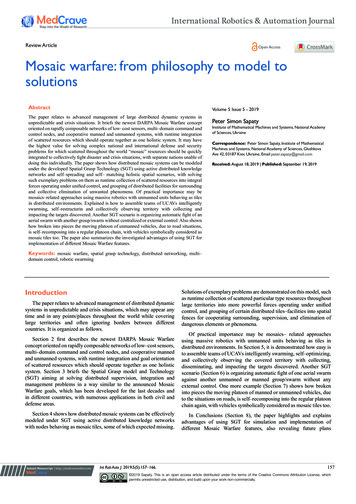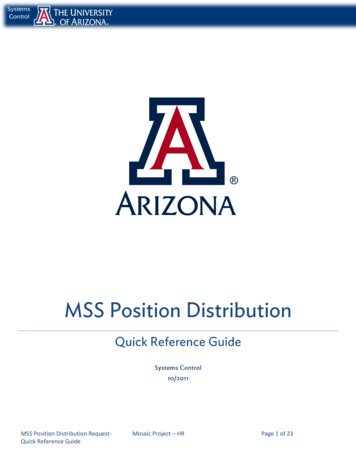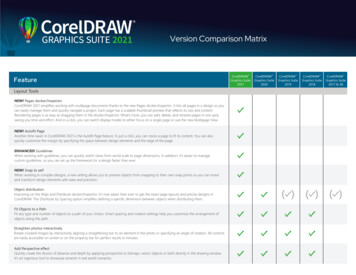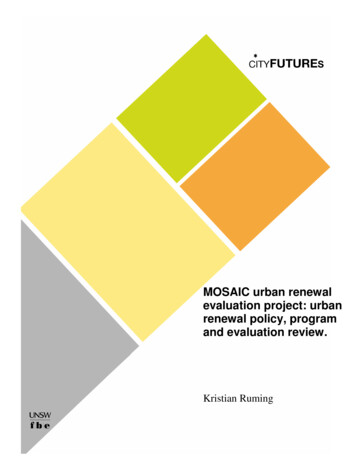
Transcription
adolescent sbirtimplementation checklistmosaicGROUPi
The Mosaic Group is a nationallyrecognized management consultingfirm and a top expert on business,public health, and human servicesstrategies. We partner with clientsacross business and communitylines to pinpoint their greatestopportunities, focus on theircrucial challenges, and modifytheir organizations.For more information, please visitwww.groupmosaic.com. 2016Special thanks to our co-partner forsupporting this work: The ConradN. Hilton Foundation was createdin 1944 by international businesspioneer Conrad N. Hilton, whofounded Hilton Hotels and left hisfortune to help the world’s disadvantaged and vulnerable people.The Foundation currently conductsstrategic initiatives in six priorityareas: providing safe water, endingchronic homelessness, preventingsubstance use, helping childrenaffected by HIV and AIDS,supporting transition-age youth infoster care, and extending ConradHilton’s support for the work ofCatholic Sisters. From its inception,the Foundation has awardedmore than 1.4 billion in grants,distributing 107 million in theU.S. and around the world in2015. The Foundation’s currentassets are approximately 2.5 billion. For more information, pleasevisit www.hiltonfoundation.org.
the Adolescent SBIRT Checklist (ASC) is a tool designed to provide organizations with a setof critical steps that will help ensure that Screening, Brief Intervention and Referral to Treat-ment (SBIRT) becomes a sustainable, integrated part of routine care. This tool was developed byconsultants at the Mosaic Group and is based on successful experience implementing and integrating SBIRT services into a variety of care settings. The steps contained in this checklist havebeen found to be essential in order to achieve optimal, sustainable SBIRT implementation. TheASC provides organizations with an implementation structure that allows for customization of aprotocol that is unique to a variety of practice settings and clinical and staffing models.The typical SBIRT implementation process occurs over a twelve-month period consisting ofthree planning months and nine months of practice implementation. Based on Mosaic Group’sthe steps contained in this checklist havebeen found to be essential in order to achieveoptimal, sustainable SBIRT implementation.experience, it is evident that certain steps buildand develop on each other and are subsequentlycritical to complete in chronological order.If these steps are completed out of order, the ASC will not support the most effective SBIRTimplementation and integration. Additional steps in the ASC may be completed as appropriatedepending on the specific care setting or organizational needs. Steps with numbers in yellowboxes should be completed in order, and steps with numbers in green boxes may be completed asappropriate according to the organization’s planning circumstances and unique considerations forSBIRT implementation. Importantly, steps with numbers in green boxes must still be completedand are critical for successful SBIRT implementation.Accompanying each step in this tool is an SBIRT Checklist User Guide. The User Guide providesmore information and guidance about each of the checklist steps; gives organizations and sitesadditional relevant information on how to put into action the steps, stemming from previousexperiences, lessons learned and best practices; includes references to sponsoring organizationsthat may be providing materials and/or technical assistance to sites and organizations imple-menting SBIRT services; contains setting-specific considerations to help organizations tailor theimplementation process to the needs of their care setting; and presents recommendations forschool-based health centers, behavioral health providers, primary care settings, and communitybased organizations.1
gain commitmentfrom senior leadership1Secure a commitment from the organization’s highest-level senior executive and senior clinicalleader. Ensure that the identified leaders are willing to dedicate the time and resourcesnecessary for effective, sustainable SBIRT implementation. Identify the alignment ofSBIRT services with the organization’s mission and business plan. Work with the leadersto ensure that they are committed and willing to allocate the personnel and other supportnecessary for effective, sustainable SBIRT implementation into routine care.Form a multidisciplinarysbirt planning/implementation team2Identify leadership from key organizational units that will play a role in SBIRT planningand implementation. It is recommended that leaders from the following units should beengaged as part of the planning and implementation team: clinical leadership, practicemanagement, IT, quality improvement, case management, behavioral health services.Convene the kick-off planning meeting of the SBIRT team. The primary goal of this meetingis to introduce the team to the SBIRT planning process and familiarize team memberswith the steps of SBIRT implementation. Team members should also understand theirrole in the planning process. At this meeting it is useful to discuss the overall SBIRTmodel and how it is typically implemented in the setting and discuss opportunities andchallenges that the team will need to consider moving forward in the work. Additionally,it is useful to identify the electronic health record vendor and the process to adapt thesystem to support SBIRT implementation. Experience has shown that it is critical thatkey organizational leadership (administrative and clinical) be present at this meeting todemonstrate support.Reconvene the planning team at key points during the SBIRT implementation process tocontinue to develop the protocol, discuss progress, challenges, data, and sustainability.2
Conduct organizationworkflow analysis3Conduct a comprehensive walk-through of the practice/setting that will be the focus forSBIRT implementation. The analysis will document the workflow, describing howpatients/clients are processed within the setting from entry, through care services,and ultimate completion of the care visit. The analysis should document key roles,decisions, and processes that a patient and provider/staff member will encounterduring a visit. If multiple locations of the same organization participate in SBIRTimplementation, separate workflow analyses are only necessary if there are specificidentified differences across sites.Produce flow charts of the practice. Charts should accurately and comprehensivelyreflect the workflow analysis above and focus on the reality of the care setting, not anoperations manual.Review flow charts with the SBIRT planning team and modify as needed to ensureaccuracy and acceptance.
Develop sbirt protocolIdentify within the organization the target population of youth and young adults that will bereceiving SBIRT services. Organizations may have multiple services offered to adolescents(e.g., primary care, dental, behavioral health) and the organization should decide up-front4which youth will be screened and, based on results, will receive subsequent SBIRT services.Select a standardized screening instrument for the target youth population. Evaluate differentvalidated screening instruments appropriate to the population of youth and young adultsto be screened. For example, screening instruments for youth under 21, such as the six-question screening tool CRAFFT, may be most appropriate; however, organizations shouldalso evaluate screening instruments for adults that may be more appropriate with olderyouth. Importantly, select one most appropriate instrument to be used with the entireyouth population to be served.Identify the substance use screening frequency. Organizations provide services to youth atvarying levels of intensity, which will help to inform decisions regarding screening frequency.For example, organizations must decide whether to universally screen every patient/clientat every encounter, or will there be a different interval (e.g., all new patients, a specificintervention or visit).Analyze the work flow to identify how best to integrate SBIRT services. Experience has shownthat this step is critical to identify the roles and staff that will support each step of theSBIRT process; this will serve as the foundation for developing the protocol as a step-wiseprocedure from every operational perspective.Draft a written SBIRT protocol. Document all of the policies, roles, and procedures into aformal, written SBIRT protocol. This document should be drafted in a format that can beincorporated into the organization’s policy manual.Review SBIRT protocol with the full SBIRT team and gain approval. Have the SBIRT teammembers sign off on the operational plans to signal their consensus. If team memberssuggest specific edits, modify the protocol as warranted to achieve consensus.4
electronic health records(ehr) modifications5Understand the organization’s EHR vendor/consortium status to identify feasibility and EHRworkflow. Organizations will have different vendors (e.g., Epic, NexGen) and processessurrounding EHR modifications. We believe it is critical to understand these factors withinthe context of SBIRT implementation in the particular care setting in order to make thecorrect modifications.Understand EHR capabilities for modifications and data reporting. Different EHR vendorsand interfaces will have varying requirements for modification. It is important to workwith the organization’s IT staff to understand what will need to be done in order tosuccessfully integrate SBIRT into the EHR system.Modify EHR to incorporate and document SBIRT services into medical records.Produce screenshots of SBIRT in the EHR to review outputs and modifications — run a samplepatient through the record and produce a sample data report. This is a critical step in order totest functionality and identify whether or not the modifications were successful.bill and codefor sbirt services6Identify codes within the specific state and setting that will be used to code for SBIRT servicedelivery.Work with IT and staff to modify EHR to support SBIRT services billing and reimbursement.This step is critical in integrating SBIRT service codes into the existing EHR system. Theremust be a fluid process of designating when SBIRT services are completed and the subse-quent billing designation.Continually monitor the billing process to ensure SBIRT service reimbursement is occurring.5
Provide staff trainingDevelop customized training for all staff impacted by SBIRT.7Develop protocols for on-the-job training for new employees once SBIRT is effectivelyinstitutionalized.Have SBIRT team members review and sign off on training protocols to signal their consensus.Conduct training for all staff to be impacted by SBIRT.Distribute relevant educational materials and tools to providers. Available materials suchas the standard drink chart, readiness ruler, and the SBIRT provider checklist are valu-able for successful SBIRT implementation. These tools help both the patient and providerremember important information relative to the SBIRT process.Conduct booster trainings approximately every two or three months to review and refresh staffon SBIRT. Booster trainings also serve as a critical forum to address barriers/challenges to SBIRT implementation, as well as reinforce successes.Establish thereferral to treatment (rt) process8Verify referral to treatment contact/staff responsible within the organization and/or site.Profile available resources in the community to understand locations and services relative to thespecific setting and needs.Develop RT protocol for the organization and give to all care managers.Hold “meet and greet” sessions to introduce the SBIRT site to treatment providers so that theycan get to know specific key personnel, such as intake workers at the treatment locations.Train all staff and providers on how the RT process will work and provide support/assistanceas needed.6
track and analyze data to practicecontinual process improvement9Define frequency, source, and methodologies for collecting data. Once a site/organizationgoes live with SBIRT, data should be reported monthly via the provided Data ReportingTemplate.Provide feedback for the SBIRT planning team on a monthly basis. Monthly and quarterlydata will be analyzed such as numbers of encounters or unique patients, screeningpercentages, the number of brief interventions conducted, and the number of patients/clients referred to treatment. All staff and team members should be engaged in aconversation about the implications of the data — what is working well, and whereimprovement is needed.Continue monthly feedback for at least six months, until the practices are fully integrated intoroutine operations.Monitor effectiveness of protocols and modify as necessary to improve performance.Ensure sbirt sustainabilityas an integrated part of care10Establish a standardized method for SBIRT performance evaluation and new hire training.If possible, SBIRT evaluation should be competency-based (observation of skills) andconducted annually.Develop a SBIRT orientation tailored to the specific organization and/or setting. New staffshould be thoroughly trained on the SBIRT process to ensure no gaps in administration.Institutionalize the quality improvement process through focused monthly reviews withleadership and staff.Assure financial support is sustained for grant-funded staff. Experience has shown that it iscritical to secure sustained funding for staff members who may be funded through grantdollars that will eventually end.7
user guideEach of thesections below corresponds to the numbered segmentin the Checklist. This guide is intended to provideadditional information and support drawing from theMosaic Group’s experience in SBIRT implementation.Additional comments are included to provide organizations with considerations for specific care settings.
gain commitmentfrom senior leadershipThis first step is critical in the SBIRT implementation process. Experience in SBIRTimplementation continues to show a direct correlation between senior leadershipsupport and the success of SBIRT implementation across all settings. In preparationfor this step, research should be done to understand the leadership setting withinthe context of SBIRT implementation. This will help to identify potential alignmentbetween the SBIRT process and the missions, business plan, and goals of an organization; clear interests of senior leadership. This will create an effective case during thepresentation of SBIRT as a valuable component of the organization. It is importantto engage both management/administrative leadership and clinical leadership, asappropriate. For example, working with the CEO of an organization as well as thesenior clinical leader will create a comprehensive support network that will ensurethe greatest buy-in across the organization. The composition of senior leadership will1vary across settings and it will be important to identify the correct personnel duringthe start of the SBIRT implementation process. It may also be applicable to engagepolicymakers to support the SBIRT process. For example, the state Medicaid Directormay need to activate the SBIRT billing codes and intervene if there is difficultysecuring reimbursement for SBIRT services. State or local elected officials may needto approve budget allocations or changes in statutes.Considerations for specific care settings: S CHOOL-BASED HEALTH CENTERS (SBHCs): In SBHCs, it is important to have afirm understanding of the organizational structure. Some SBHCs are privately run orhave private providers, and subsequently will require different parties to be presentat the stakeholder table. For example, if an SBHC has an FQHC private healthcareprovider, the CEO and clinical leaders of the overall sponsoring organization shouldbe present at the initial meeting, as their support is critical. Similarly, if the countyhealth department or school district runs the SBHC, research must be done tounderstand who the relevant senior leadership stakeholders are in relation to schoolhealth; successful implementation will likely require access to the high-level school9
district staff. Once this level of leadership has been established, it is then necessaryto engage with the school principals and other critical student support service teammembers to create the most comprehensive collection of key stakeholders. P RIMARY CARE SETTING: In a primary care setting, an assessment should bemade of the organizational structure to understand the correct leadership membersto engage. For example, an organization’s CEO and senior clinical leaders shouldbe actively engaged in order to create a comprehensive leadership network. Theleadership hierarchy in a primary care setting will likely be straightforward, andsuccessful SBIRT implementation will ensure that all of the key staff are present atthe initial meeting to show full support. B EHAVIORAL HEALTH PROVIDERS: In a behavioral health provider setting, theCEO of the organization and high-level clinical services leaders, such as the directorof clinical services, should be engaged to provide support for the SBIRT process.These leaders will have substantial influence on organizational processes and1their support will ensure that SBIRT becomes a sustainable and integrated part ofhealthcare delivery. C OMMUNITY-BASED ORGANIZATIONS: Community-based organizations requireadditional care and research in attempting to understand the key stakeholders toengage during SBIRT implementation; this is due to the varying organizationalmissions and structures. These organizations will typically have a diverse leadershipteam and it will be critical to identify and gain support across teams to successfullyimplement SBIRT. Additionally, larger community-based organization may have anational focus whereas others may be regionally focused, and fully understandingthis organizational structure will be important to identify the most appropriate staffmembers to include in the leadership team.10
Form amultidisciplinary sbirtplanning/implementation teamEffective SBIRT implementation requires the buy-in and participation of manydifferent levels of staff within the organization or care setting. Subsequently, it iscritical to implementation that a multidisciplinary planning and implementationteam is created. Experience in SBIRT implementation continues to show that in orderto ensure successful implementation, buy-in must be achieved from the top-downand bottom-up of an organization; key leaders from organizational units need tobe identified and engaged. In addition to service providers (e.g., counseling, clinicalservices, behavioral health services) and leadership (e.g., executive and clinical), theSBIRT implementation team should be comprised of staff including IT personnelor those who work with EHR, human resource staff, and training professionals, as2appropriate. The senior leadership engaged previously should provide guidance onthe organizational structure to identify the most critical staff members to be a part ofthe SBIRT team. Senior leadership should also provide insight into the staff memberswho most appropriately represent functional units at a management level; these staffmembers will be influential in the SBIRT implementation process, as they have developed relationships with the day-to-day functions. The exact composition of this teamwill vary across organizations and settings. After establishing the critical members,the SBIRT implementation team should have a kickoff meeting. The primary goalof this meeting is to introduce the team to the SBIRT implementation process andprovide information on the SBIRT model and its relevance to the specific care setting.Basic information should be given to provide a groundwork level of understanding. Additionalin-depth information may relate to the EHR; modifying electronic healthrecords can often take time and delay the start of implementation, underscoring theimportance of initiating the conversation early and having IT staff on the planningteam. Furthermore, the SBIRT planning team should understand their responsibilitiesmoving forward through implementation and be prepared to actively participate inthe workflow analysis, protocol development, data review, and sustainability plan.11
Considerations for specific care settings: S CHOOL-BASED HEALTH CENTERS: Depending on the type of SBHC, the keyleadership identified previously as well as all relevant clinical staff should be present;the composition of this clinical staff may vary. For example, a SBHC may havea director of nursing, nurse practitioners, and a school social worker all actively2involved in the delivery of healthcare services. Subsequently, the SBIRT implemen-tation team should include all of these staff members, as appropriate, as well asthe associated IT staff; student support staff such as school psychologist, guidancecounselor, or social worker; and the principals or vice principals. P RIMARY CARE SETTING: In a primary care setting, the SBIRT implementationteam will be comprised of executive leadership when applicable (CEO of a careorganization), as well as the clinical managers, practice manager, behavioral health/social work services, and relevant primary care providers. Furthermore, HR and ITstaff involved in the training/onboarding of new personnel and the relevant EHRmodifications should be engaged. It is critical to successful SBIRT implementationthat a diverse collection of staff members be assembled to create a network of support. B EHAVIORAL HEALTH PROVIDERS: Similar to above, in a behavioral healthprovider setting, senior leadership must be included in the SBIRT implementationteam. Additionally, the clinical director, IT staff responsible for EHR modificationand maintenance, staff members involved in the referral to treatment process, andany relevant case manager should be included. C OMMUNITY-BASED ORGANIZATIONS: Community-based organizationsagain pose significant considerations due to the varying organizational structures.Significant work and research should be done to identify key members, includingleadership, IT and data staff, referral to treatment staff, and other management staffwho have direct relationships with the youth. For example, in an organization thatoffers vocational training, the director of a specific area may be extremely influentialand important to the SBIRT delivery process; this staff member should absolutely beincluded in the implementation process.12
Conduct organizationworkflow analysisThe workflow analysis process provides a structure and outline for the developmentof an SBIRT protocol and ultimately the entire SBIRT implementation process. AnSBIRT workflow analysis begins with a comprehensive walk-through of the clinic,practice or setting where the SBIRT services will occur. The primary goal of theworkflow analysis is to document how patients/clients are processed within thecare setting. The analysis should begin with a documentation of the patient/cliententry and initial form completion, the processing of those forms, the delivery of careservices including any relevant time windows, and end with the ultimate completionof the visit with any associated documentation. All staff members and roles shouldbe clearly highlighted in the workflow to provide a comprehensive understanding3of the players involved in the delivery of SBIRT services. Importantly, within anorganization there will be different staff members and/or professionals who supportvarious components of the SBIRT process, and experience has shown it is criticalto outline these roles in the workflow analysis. For example, often times the staffmember responsible for SBIRT screening will not be the same person who providesthe client with a brief intervention; this relationship should be documented withinthe workflow analysis to provide clarity and a comprehensive understanding. Inaddition to the staff members involved, all processes, decisions, and policies shouldbe documented; these will significantly impact SBIRT implementation and mustbe noted at the correct places along the workflow. It is important that all of theseitems come together to effectively tell a story about what the patient/client will encounterthroughout the entire delivery of services so that SBIRT may be optimallyimplemented within the specific care setting. It is very important to understand thedynamic within the visit between the parent and provider; meaning, when is theparent present during the visit, and will SBIRT services be delivered during this time.Experience in SBIRT implementation has shown that the presence of a parent mayinfluence the responses of adolescents, and subsequently this should be considered13
during implementation. Once the full workflow has been documented, flow chartsof the practice/care setting should be created to visualize this workflow. This visualization needs to accurately reflect the reality of the care setting, including the EHRprocess, and not a procedure or operation manual. It is important that this workflowanalysis is conducted thoroughly and realistically in order to ensure successful SBIRTimplementation.Considerations for specific care settings: S CHOOL-BASED HEALTH CENTERS: In an SBHC, the workflow analysis should3mirror a walk-through from the time the student enters the health center to thetime they leave, including all the personnel he/she interacts with. A successfulworkflow analysis will understand the relationships a student will develop with staffmembers and the associated dynamic. For example, what/how much information isshared, interactions with the classroom teacher, parental involvement, and additionalstudent support services. A workflow of an SBHC should consider all potentialresources and personnel that a student will encounter and may require research andconversation outside of the specific care setting walk-through. B EHAVIORAL HEALTH PROVIDERS: It is critical to understand the intake andassessment process and type/level of information collected in a behavioral healthprovider care setting. For example, a workflow analysis should identify what type, ifany, of substance abuse assessment is currently being performed and by what staffmembers. This information will help guide the SBIRT implementation process andassure that there is no duplication or overlap of services and questions. A primarygoal of early SBIRT implementation is to find a place during the healthcare work-flow to have SBIRT become seamlessly integrated (ie., fill a current gap in services).Additionally, the workflow analysis should fully outline the process of an adolescentvisit, including the stepwise intake process and frequency of clinical interactions.14
P RIMARY CARE SETTING: A primary care workflow analysis should clearly document a walk-through from the time a patient enters the practice to the time the3patient leaves. For example, an effective workflow analysis will document how apractice triages patients, the specific sets of a screening tools currently being used,when screening occurs, the key staff members involved, and the presence of anycurrent referral to treatment processes. Furthermore, this analysis should outlineadditional relevant staff members such as a health educator, case manager, or socialworker that will be actively in contact with a patient during a primary care visit. C OMMUNITY-BASED ORGANIZATIONS: Workflow analysis in a community-based organization should thoroughly document the different levels/frequenciesof interaction, intake, and assessment an adolescent may encounter. Carefulconsideration should be made as to what evaluations are currently being done andat what points during client encounters. A community-based organization mayhave specific criteria or protocols established for substance abuse testing that cansignificantly impact the SBIRT process. For example, an adolescent in a community-based organization may have to perform routine urine toxicology tests, and ifpositive, be discharged or sent for treatment. This outcome may be in conflict withthe SBIRT process associated with reducing use over time, and the workflow analysisshould highlight this conflict so that the SBIRT planning team can discuss the mostappropriate method of integrating SBIRT as a part of care delivery.15
adolescent ’s habits change frequently and it iscritical to repeat the screening process to capturethese changes and normalize the conversation.16
Develop sbirt protocolProtocol development serves as the foundation for systems-level change, which isnecessary to integrate SBIRT as a routine part of care and ensure sustainability pastthe end of the grant period. This step directly stems from the previous workflowanalysis and SBIRT planning/implementation team meetings. Before designing anddrafting the SBIRT protocol, it is critical to clearly understand the target populationand appropriate screening tool. For example, research should be conducted to identify any potential subsets within the adolescent clients that will particularly benefit4from SBIRT services. For example, in an SBHC, many healthcare visits may be forroutine services such as over-the-counter medication administration; a decision mustbe made as to whether or not these youth will receive SBIRT screening at that visit,or only as appropriate. Additionally, the screening tools and methods of screeningwill vary across sites and settings. For example, some organizations and/or sitesmay screen on the computer or tablet, in contrast to a paper and manual data entrymethod. These variations should be clearly documented in the SBIRT protocol withcorresponding considerations such as patient privacy/confidentiality and data entrytimelines in order to most effectively support the overall SBIRT screening process.Although the CRAFFT is the most common
Checklist (ASC) is a tool designed to provide organizations with a set of critical steps that will help ensure that Screening, Brief Intervention and Referral to Treat-ment (SBIRT) becomes a sustainable, integrated part of routine care.This tool was developed by consultants at the Mosaic Group and is based on successful experience implementing and inte-










